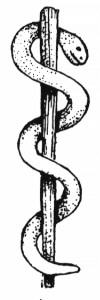ca•du•ce•us (kuh-DOO-see-uhs, -shuhs) n
Definition:
1. the staff carried by Mercury as messenger of the gods (Classical Mythology)
2. an emblem of the medical profession and as the insignia of the U.S. Army Medical Corps
caducei plural; caducean adjective
Origin:
1577; from L. caduceus, alteration of Doric Gk. karykeion "herald's staff," from karyx (gen. karykos) "a herald," from PIE *karu-, from base *kar- "to praise loudly"
Sentence Examples:
• At an examination the President sits at the end of the table with his back to the fireplace, the Registrar (Dr. Liveing) opposite, and the Censors on either side. In front of the President is a cushion with the Caduceus, the Mace, and the Golden Cane. - Personal Reminiscences of Sir Andrew Clark, E H Pitcairn
• He woke again, fitfully, and it would be daylight and he could see the yellow sky through an open window or it would be night and the wall-lights would be on. There would always be somebody with him. Nikkolay's wife, Dame Cecelia; Rovard Grauffis; Lady Lavina Karvall—he must have slept a long time, for she was so much older than he remembered—and her brother, Burt Sandrasan. And a woman with dark hair, in a white smock with a gold caduceus on her breast. - Space Viking, Henry Beam Piper
• My companions laughed, but I plucked up my courage and did not hesitate, but went on and examined the entire wall. There was a scene in a slave market, the tablets hanging from the slaves' necks, and Trimalchio himself, wearing his hair long, holding a caduceus in his hand, entering Rome, led by the hand of Minerva. - The Satyricon, Petronius Arbiter
Why This Word:
Caduceus, staff carried by Hermes, the messenger of the gods, as a symbol of peace. Among the ancient Greeks and Romans it became the badge of heralds and ambassadors, signifying their inviolability. Originally the caduceus was a rod or olive branch ending in two shoots and decorated with garlands or ribbons. Later the garlands were interpreted as two snakes entwined in opposite directions with their heads facing; and a pair of wings, in token of Hermes’ speed, was attached to the staff above the snakes. Its similarity to the staff of Asclepius the healer (a staff branched at the top and entwined by a single serpent) resulted in modern times in the adoption of the caduceus as a symbol of the physician and as the emblem of the U.S. Army Medical Corps.
Many "medical" organisations use a symbol of a short rod entwined by two snakes and topped by a pair of wings, which is actually the caduceus or magic wand of the Greek god Hermes (Roman Mercury), messenger of the gods, inventor of (magical) incantations, conductor of the dead and protector of merchants and thieves. It is derived from the Greek karykeion = "herald's staff", itself based on the word "eruko" meaning restrain, control.
It is interesting to see that most of organisations using this symbol are generally either commercial or military (or American). New Zealand examples include drug and pharmaceutical companies. A study by Friedlander confirms this impression.
The link between the caduceus of Hermes (Mercury) and medicine seems to have arisen by the seventh century A.D., when Hermes had come to be linked with alchemy. Alchemists were referred to as the sons of Hermes, as Hermetists or Hermeticists and as "practitioners of the hermetic arts". There are clear occult associations with the caduceus.
The caduceus was the magic staff of Hermes (Mercury), the god of commerce, eloquence, invention, travel and theft, and so was a symbol of heralds and commerce, not medicine. The words caduity & caducous imply temporality, perishableness and senility, while the medical profession espouses renewal, vitality and health.
Professional and patient centred organisations ... use the "correct" and traditional symbol of medicine, the staff of Asclepius with a single serpent encircling a staff, classically a rough-hewn knotty tree limb. Asclepius (an ancient greek physician deified as the god of medicine) is traditionally depicted as a bearded man wearing a robe that leaves his chest uncovered and holding a staff with his sacred single serpent coiled around it, (example right) symbolizing renewal of youth as the serpent casts off its skin. The single serpent staff also appears on a Sumerian vase of c. 2000 B.C. representing the healing god Ningishita, the prototype of the Greek Asklepios.
Staff of Asclepius
Sources: Dictionary.com, Online Etymology
Word-E: A Word-A-Day



No comments:
Post a Comment